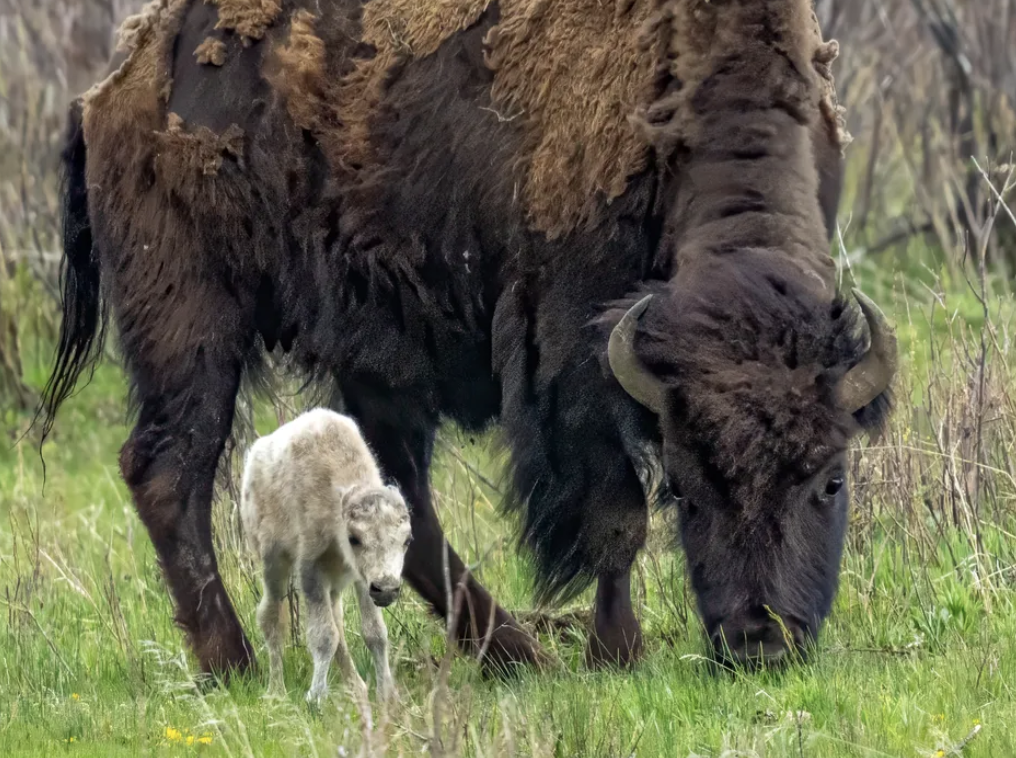
- Details
- By Levi Rickert
For the first time since the birth of a rare white bison calf on June 4, 2024 in Yellowstone National Park, national park officials acknowledged its birth. The acknowledgement came in a press release yesterday. The press release indicated that the birth was the first known birth of a white bison in Yellowstone National Park.
White bison are exceedingly rare and are often considered a sacred symbol among various Native American tribes. The white coloration may result from a genetic mutation known as leucism, which causes patches of white coloration on the skin or fur. The birth of a white bison calf in the wild is believed to occur in 1 in 1 million births or even less frequently.
“Yellowstone’s Center for Resources Bison Management Team received numerous reports and photos of the calf taken on June 4 from park visitors, professional wildlife watchers, commercial guides and researchers,” the press release said.
The unique white calf was given the name Wakan Gli–which means “Return Sacred”in Lakita–in a ceremony during a traditional Lakota ceremony on Wednesday by Chief Arvol Looking Horse, 19th Generation Keeper of the Sacred White Buffalo Calf Pipe and Bundle.
Even with the acknowledgement of the Wakan Gli’s birth, there have been no additional sightings of the young bison since June 4.
“To date, park staff have been unable to locate the calf,” the press release stated. “To our knowledge, there have been no confirmed sightings by park visitors since June 4.”
Without sightings, it is not known if Wakan Gli is still alive. Each spring, about 1 in 5 bison calves die shortly after birth due to natural hazards, according to national park officials.
Bison calves are born in a single pulse during late spring and early summer. The national park service completes an annual post-calving count each August.
The birth of a white bison calf was a rare natural phenomenon that once occurred before the near extinction of bison in the late 19th century, when bison numbered in the tens of millions.
The birth of a white bison calf may reflect the presence of a natural genetic legacy that was preserved in Yellowstone’s bison, which has revealed itself because of the successful recovery of a wild bison population of 3,000-6,000 animals.
The bison population fluctuates from 3,000 to 6,000 animals in two subpopulations, defined by where they gather for breeding. The northern herd breeds in the Lamar Valley and on the high plateaus around it. The central herd breeds in Hayden Valley.
The birth of a white bison calf was a rare natural phenomenon that once occurred before the near extinction of bison in the late 19th century, when bison numbered in the tens of millions.
The birth of a white bison calf may reflect the presence of a natural genetic legacy that was preserved in Yellowstone’s bison, which has revealed itself because of the successful recovery of a wild bison population of 3,000-6,000 animals.
The bison population fluctuates from 3,000 to 6,000 animals in two subpopulations, defined by where they gather for breeding. The northern herd breeds in the Lamar Valley and on the high plateaus around it. The central herd breeds in Hayden Valley.
More Stories Like This
Native News Weekly (August 25, 2024): D.C. BriefsUS Presidents in Their Own Words Concerning American Indians
Indigenous Actor Elaine Miles Reports Detention by Alleged ICE Agents
Happy Thanksgiving from Native News Online
Coming Up on Native Bidaské: Behind the Animation: Joey Clift Talks “Pow” and Native Storytelling
Help us tell the stories that could save Native languages and food traditions
At a critical moment for Indian Country, Native News Online is embarking on our most ambitious reporting project yet: "Cultivating Culture," a three-year investigation into two forces shaping Native community survival—food sovereignty and language revitalization.
The devastating impact of COVID-19 accelerated the loss of Native elders and with them, irreplaceable cultural knowledge. Yet across tribal communities, innovative leaders are fighting back, reclaiming traditional food systems and breathing new life into Native languages. These aren't just cultural preservation efforts—they're powerful pathways to community health, healing, and resilience.
Our dedicated reporting team will spend three years documenting these stories through on-the-ground reporting in 18 tribal communities, producing over 200 in-depth stories, 18 podcast episodes, and multimedia content that amplifies Indigenous voices. We'll show policymakers, funders, and allies how cultural restoration directly impacts physical and mental wellness while celebrating successful models of sovereignty and self-determination.
This isn't corporate media parachuting into Indian Country for a quick story. This is sustained, relationship-based journalism by Native reporters who understand these communities. It's "Warrior Journalism"—fearless reporting that serves the 5.5 million readers who depend on us for news that mainstream media often ignores.
We need your help right now. While we've secured partial funding, we're still $450,000 short of our three-year budget. Our immediate goal is $25,000 this month to keep this critical work moving forward—funding reporter salaries, travel to remote communities, photography, and the deep reporting these stories deserve.
Every dollar directly supports Indigenous journalists telling Indigenous stories. Whether it's $5 or $50, your contribution ensures these vital narratives of resilience, innovation, and hope don't disappear into silence.
 The stakes couldn't be higher. Native languages are being lost at an alarming rate. Food insecurity plagues many tribal communities. But solutions are emerging, and these stories need to be told.
The stakes couldn't be higher. Native languages are being lost at an alarming rate. Food insecurity plagues many tribal communities. But solutions are emerging, and these stories need to be told.
Support independent Native journalism. Fund the stories that matter.
Levi Rickert (Potawatomi), Editor & Publisher

